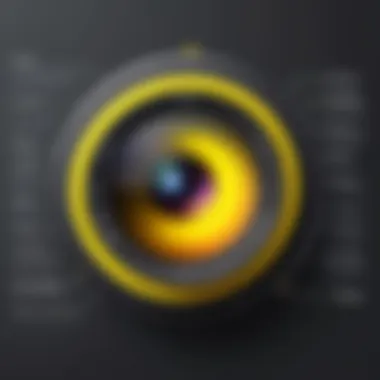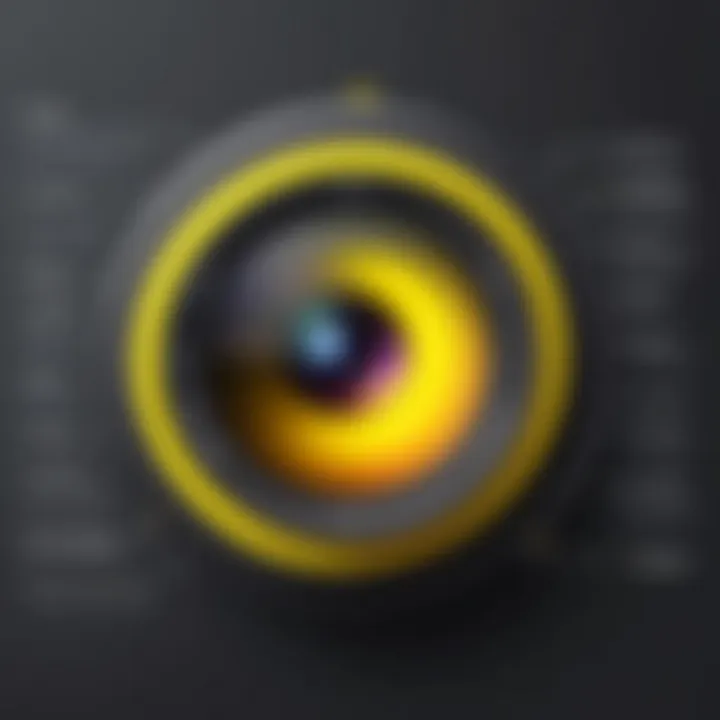Mastering the Art of Snapchat Lens Creation


Intro
In the realm of social media, Snapchat has carved a unique niche, particularly with its engaging features like lenses. Creating a Snapchat lens presents a compelling opportunity for users to express creativity, enhance interactions, and drive engagement. This guide aims to unpack the process of creating lenses on Snapchat, illuminating the technology, design methods, and submission steps involved.
Overview of the Technology
Key specifications
Snapchat lenses operate on advanced augmented reality technology. They utilize facial recognition to overlay digital images and effects onto real-world environments. This technology employs both depth tracking and object recognition, allowing users to interact seamlessly with virtual objects. The platform relies on software enhancements and robust hardware performance, predominantly found in modern smartphones.
Unique selling points
The user engagement offered by Snapchat lenses is noteworthy. They provide a dynamic way for users to transform their appearances or enhance photographs creatively. The simplicity of activation through the Snapchat camera paired with the potential for viral sharing distinguishes Snapchat lenses from other social media features. Moreover, the vast library of existing lenses serves as inspiration for creators, highlighting a community focused on innovation.
Lens Creation Process
Creating a Snapchat lens involves several steps, ranging from conceptualization to submission. Users should first consider their target audience and the message they wish to convey.
Design Tips
When it comes to lens design, clarity and appeal are paramount. Here are some recommendations:
- Use vibrant colors: Bright and engaging colors can attract attention and improve the likelihood of user engagement.
- Focus on clarity: Overly complicated designs may confuse users, while simple and clear visuals can enhance the experience.
- Test emotions: Incorporating elements that evoke emotions can increase the lens's popularity.
Tools for Creation
Before diving into creation, familiarize yourself with the tools available. Snapchat provides Lens Studio, a robust application for designing lenses. This platform includes numerous templates, 3D objects, and editing capabilities. Using Lens Studio, you can build complex lenses with interactive elements easily.
Submission Guidelines
After creating your lens, its submission is the next step. Ensure that the lens adheres to Snapchat’s community guidelines. Also, include a catchy name and description to make it memorable for users.
Engaging an Audience
Once published, keep an eye on user engagement. Monitoring feedback and making adjustments can elevate the lens’s effectiveness. Following trends allows creators to refine their work, ensuring it remains relevant in a fast-moving social media environment.
Ultimately, creating a Snapchat lens is not just about aesthetics; it’s about enhancing user interaction through thoughtful design and technological savvy.
By following these steps and recommendations, users can successfully craft engaging and innovative Snapchat lenses, making their mark in the vibrant sphere of social media.
Prelude to Snapchat Lenses
Snapchat lenses are more than just fun filters; they represent a powerful tool for creativity and interaction on the platform. These lenses allow users to engage with augmented reality in their daily lives, enhancing personal storytelling through immersive experiences. In this article, you will learn the step-by-step processes involved in creating your own Snapchat lenses, highlighting their importance and utility in both social and marketing contexts.
Importance of Snapchat Lenses
Snapchat lenses have transformed how users experience the platform. They elevate simple snapshots into engaging moments by adding effects that can change appearances, mimic animations, or provide context to photos and videos. For businesses and creators, they offer a unique way to connect visually with audiences. Utilizing a Snapchat lens can improve brand visibility and foster engagement in ways that traditional media cannot.
Benefits of Creating Lenses
- Creativity: Building a lens allows for personal expression and creativity. Whether it's a corporate brand message or simply a fun design for friends, the possibilities are broad and varied.
- User Engagement: Lenses can drastically enhance interactions, inviting users to share their experiences. A well-designed lens often prompts users to create and distribute content, increasing visibility and shareability.
- Market Differentiation: For brands, having a unique lens can set a business apart. It becomes an interactive advertisement, enabling consumer participation in ways traditional ads do not.
- Community Building: Creating lenses can foster a sense of community among users. Sharing unique lenses can draw attention and create conversations around shared interests.
Considerations in Lens Creation
Understanding the fundamentals of lens creation involves more than just technical skills; it includes considering audience needs and preferences. You should think about what type of lens will resonate with users, evaluate trends in design and technology, and continually seek feedback for improvement.
A successful lens will adapt as user tastes shift and technology evolves. This adaptability is crucial for keeping your creations relevant and engaging.
Understanding the Importance of Lenses
Snapchat lenses play a pivotal role in shaping user interaction and engagement on the platform. With the growing significance of augmented reality, utilizing Snapchat lenses has evolved beyond mere fun and games. It is a tool that brands, artists, and users leverage to create memorable experiences.
Enhancing User Engagement
One of the major benefits of Snapchat lenses is their ability to captivate users. When done right, a lens can encourage users to share their experiences, leading to increased visibility. Users enjoy personalized interactions, and innovative lenses fuel this excitement. The more engaging the experience, the more likely users are to use and share the lens.
"Immersive experiences are becoming the new norm. Users crave uniqueness in their digital interactions."
Driving Brand Recognition
For businesses, Snapchat lenses provide a unique avenue to establish brand identity. Lenses can be customized to resonate with target demographics. This level of personalization allows brands to connect with users on an emotional level. Companies like Taco Bell and Nike have successfully utilized lenses to promote new products, creating a buzz and drawing in customers.
Encouraging Creativity
Snapchat lenses encourage creativity not only among influencers but also users. Experimentation with design can lead to innovative ideas and potential viral trends. This aspect is essential as it keeps the content fresh and relevant. The more creative the lenses, the higher their chances of being shared, thus amplifying their reach.
Fostering Community Interaction
Being part of a community is vital in today's digital age. Snapchat lenses enable users to engage with their friends and family in a playful manner. Custom lenses can be designed for events, holidays, or personal occasions, building a sense of belonging. This interaction fosters stronger relationships, enhancing the platform's social aspect.
Epilogue
In summary, understanding the importance of Snapchat lenses is crucial for anyone looking to create and utilize them effectively. They not only heighten user engagement but also serve as a marketing tool, stimulate creativity, and nurture community ties. Therefore, getting it right can make a significant difference in user experience and content visibility.
Getting Started with Lens Creation
Getting started with lens creation is a crucial phase in developing engaging Snapchat lenses. This section introduces the initial steps necessary for utilizing Snapchat's capabilities fully. Creating a lens can enhance user interaction and creativity. It allows users to express themselves in innovative ways through augmented reality. Moreover, understanding the foundational elements offers a clearer path to harnessing the features Lens Studio provides.
To begin, one needs to know how to set up a Snapchat account. This is essential as it connects you to the wider community and allows you to publish and share your creations. Additionally, accessing Lens Studio is necessary to design and develop lenses. Both steps combine to lay the groundwork for a successful lens creation experience.


Creating a Snapchat Account
Creating a Snapchat account is straightforward. Begin by downloading the Snapchat app on your device from the App Store or Google Play. After launching the app, you will be prompted to tap on ‘Sign Up’. At this stage, you must enter required information such as your name and birthdate. Following this, create a unique username. Choose wisely, as this name is your identity on the platform.
Once you've chosen a username, it's time to set up a password. Make sure it is secure yet memorable. After that, you need to confirm your email address or phone number. Snapchat uses this for verification and security purposes. Complete the setup and delve into features that Snapchat offers. This account will be the foundation for all future lens activities.
Accessing Lens Studio
Lens Studio is an essential tool for creators looking to design Snapchat lenses. To access it, first visit the official Lens Studio website. There, you will find download links for various operating systems, including Windows and macOS. After successfully downloading and installing Lens Studio, start the application.
Upon opening Lens Studio, familiarize yourself with the user interface. It consists of multiple panels, including a preview panel, component panel, and a tools panel. This interface will allow you to build and modify your lens as needed. Lens Studio also provides a range of templates and tutorials, making it easier to start crafting your lens. These resources are valuable for both beginners and experienced creators alike.
With your Snapchat account set up and Lens Studio installed, you are now ready to explore the exciting world of lens creation. Consider potential themes or ideas that could resonate with users. This exploration of imagination marks the beginning of a rewarding creative journey.
Exploring Lens Studio Features
Understanding the features of Lens Studio is essential for anyone aiming to create a Snapchat lens. This software provides a vast array of tools and functionalities designed to enhance the lens creation process. The intuitive interface coupled with a plethora of options empowers users to develop unique and engaging lenses that can attract the attention of Snapchat users.
With Lens Studio, creators have access to various features like templates, scripting capabilities, and the ability to incorporate AR assets. These features not only simplify the lens creation but also allow for the introduction of complex interactions and stimulating visual effects. Overall, exploring Lens Studio features lays the foundation for effective lens design and user engagement.
User Interface Overview
The user interface (UI) of Lens Studio is organized and user-friendly. At first glance, users will notice a clean layout. Key components like the asset panel, preview window, and script editor are easily accessible. This layout promotes efficient workflow, enabling creators to navigate and manipulate their projects effortlessly.
- Asset Panel: This section contains all the 3D models, textures, and audio files that you plan to use in your lens. Importing assets is straightforward, and they can be organized into folders for better management.
- Preview Window: This is where creators can see how their lens will appear in real-time. It provides a direct feedback loop, making it easier to adjust elements as necessary.
- Script Editor: For those who wish to add scripting to their lenses, the script editor allows for coding interactions and advanced functionalities. Familiarity with JavaScript is beneficial here.
By knowing how to effectively use the UI, creators can streamline their projects and focus on innovative designs.
Understanding Templates and Projects
Templates in Lens Studio serve as a starting point for many users. They offer a pre-set structure, making it easier to create a lens without starting from scratch. The benefit of utilizing templates lies in the time saved during the design process. Various categories of templates are available, catering to different types of lenses, such as face filters or environmental effects.
Projects are the core of any lens developed in Lens Studio. Every project encapsulates all elements involved in creating a lens, from assets to scripts. Keeping projects organized is crucial for maintaining clarity and efficiency, especially as the complexity of a lens increases.
- Selecting a Template: Choose a template that closely aligns with your lens idea. Modify it to suit your vision without having to develop every element from the ground up.
- Organizing Projects: Assign meaningful names to your projects and assets. This will facilitate easier updates and modifications later.
Designing Your Lens
Designing a Snapchat lens is a crucial phase in its overall development. The design not only determines its visual appeal but also impacts how users interact with it. An effective lens combines aesthetics with functionality, enhancing the user experience. When crafting a lens, attention to detail in design can significantly influence its success on the platform.
The benefits of a well-designed lens are numerous. Users are more likely to engage with a lens that is visually attractive and intuitive to use. It can increase the chances of shares, which in turn amplifies the reach of your creation. Moreover, understanding the dynamics of design helps in making lenses that resonate with the audience.
There are several considerations to keep in mind during the design process. First, think about the target demographic and what engages them. Consider the context in which users might use the lens. You should also keep in mind the limitations of the Snapchat platform; for example, avoid overly complex designs that could slow down performance.
Choosing the Right Elements
Selecting the right elements for your lens is the first step in the design process. Different elements can evoke unique emotions and reactions from users. Colors, shapes, and symbols can all influence how a lens is perceived.
When choosing elements, it's recommended to adhere to principles of design such as balance and harmony. Cohesive use of colors helps maintain the lens’s aesthetic appeal. Additionally, elements must be appropriate for the intended use. A lens for a festive celebration should feature vibrant colors and fun shapes, while a more subdued lens might focus on calmer palettes and simpler forms.
You may also consider including interactive components that invite user engagement. Simple call-to-action elements, such as buttons or sliders, can enhance user involvement, making the experience richer and more immersive.
Incorporating 3D Objects and Effects
Integrating 3D objects and effects can elevate your Snapchat lens from ordinary to extraordinary. 3D models give a sense of depth and realism that flat images cannot replicate. They allow users to manipulate and interact with your designs in more engaging ways.
When selecting 3D objects, ensure they align with the overall theme of your lens. Objects should not only be visually striking but also relevant and functional. For example, if you are creating a fun party lens, consider adding animated confetti or quirky characters that react to user movements.
Real-time effects, such as animations triggered by user actions, can significantly enhance user experience. These effects make the lens feel alive, empowering users to interact in a manner that feels spontaneous and exciting. However, balance is essential. Don't overload the lens with too much movement as it can become overwhelming and distract from the core experience.
Using Textures and Materials
Textures and materials lend depth to your design, adding tactile richness and visual interest. A well-chosen texture can evoke emotions and complement the overall feeling of the lens. For instance, a lens featuring soft fabrics may convey a feeling of warmth, while metallic elements can suggest a sleek and sharp tone.
When applying textures, pay attention to their resolution and quality. Higher quality textures translate to a better user experience, especially when viewed on larger screens. Textures should be applied consistently throughout the lens to maintain visual harmony.
Moreover, consider the compatibility of textures with the Snapchat platform. Textures should not impede performance or cause delays, as this can lead to user frustration. Experimenting with various materials can also offer opportunities to enhance the aesthetic without sacrificing performance.
A clean and thoughtful application of textures, paired with a strategic use of color and shapes, will create an engaging and immersive lens for users to enjoy.
Implementing Lens Interactions
Lens interactions are crucial for enhancing user experience within Snapchat. When correctly implemented, they provide a more immersive and engaging encounter for users. Interactions make lenses dynamic and responsive, which can significantly heighten user engagement. By allowing users to interact with your lens, you encourage them to spend more time utilizing it, thus increasing its popularity and effectiveness. Different types of interactions can be used, ranging from simple taps to more complex gestures.
Key elements to consider when implementing interactions include the type of control you wish to provide and the intended user experience. You should think about the overall flow of engagement and ensure that interactions are intuitive. This approach will not only improve user satisfaction but also can enhance your lens’s visibility on Snapchat. Therefore, it’s essential to focus on thoughtful integration of these features.
Adding User Controls
User controls play a vital role in how an individual interacts with your Snapchat lens. These controls can be simple, like buttons for various effects, or more complex, like sliders that let users manipulate certain attributes of the lens. When you design user controls, focus on functionality. Users should have clear options that are easy to understand and use.
Consider the placement of these controls within the lens interface. Controls should complement your lens design, not overwhelm it. Too many options can confuse users, while too few can restrict engagement. Testing how users interact with these controls is important. Utilize metrics from Lens Studio to observe how users engage with them.
Key Points for User Controls
- Simplicity: Clear and easy-to-use controls.
- Functionality: Controls should facilitate user experience.
- Placement: Controls should not detract from the visual elements of the lens.
Integrating Audio and Visual Effects
Adding audio and visual effects is another powerful way to enhance interactions within Snapchat lenses. These elements provide an additional layer of engagement and can create a more immersive experience. For instance, incorporating sound effects can give feedback to user actions like tapping or swiping. This auditory feedback reinforces the interaction, making it feel more real.
Visual effects, on the other hand, can transform simple interactions into captivating phenomena. Consider how animations can respond to user input.


- Example: A lens that adds sparkles when a user taps the screen.
To implement these effects within Lens Studio, familiarize yourself with its audio and animation tools. Experiment with different sound clips and visual sequences to determine what best aligns with your lens’s theme. Be mindful of not overwhelming the user with too many effects, as this can lead to confusion. Strive for a balance where audio and visual enhancements enrich the experience without distracting from the primary content of your lens.
By effectively integrating user controls and audio-visual effects, you can create a captivating Snapchat lens that not only attracts users but also encourages longer interaction times. For those looking to innovate within this space, these strategies can serve as a fundamental step in lens creation.
Testing Your Lens
Testing a Snapchat lens is a critical phase in the creation process. This step ensures that your design and functionality align with your vision. It aids in spotting any issues before public release, thereby enhancing user engagement and satisfaction. Testing provides insights into how users will experience the lens, which might differ from your expectations. Thus, it's not just a beneficial practice; it's essential for a successful launch.
Utilizing Preview Features in Lens Studio
Lens Studio offers a variety of preview features designed to give you a real-time view of how your lens will appear and perform. These features enable you to simulate interactions, ensuring that all elements function as intended.
You can toggle between different modes, such as how the lens appears on various devices. The preview feature includes options for testing environmental effects, interactions, and animations. Utilize this effectively to identify any glitches or design flaws early on.
Here are a few key aspects of utilizing preview features:
- Real-time Feedback: Instant visual feedback allows you to make adjustments efficiently.
- Cross-Device Compatibility: Test how the lens behaves on different smartphones and in various lighting conditions.
- User Interaction Simulation: Engage with your lens as an end user would. This stage is vital for checking responses to actions like tapping or swiping.
Gathering Feedback from Test Users
Getting input from test users is another dimension of testing your lens. Feedback is invaluable, as it provides diverse perspectives on usability and enjoyment. Involving target users can reveal aspects you might have overlooked.
Establish a small group of individuals who represent your intended audience. Ask them to use the lens and provide insights on functionality, aesthetic appeal, and user experience. Here are essential considerations for gathering feedback:
- Ask Specific Questions: Inquiries such as "What did you find confusing?" or "Did the interactions function as expected?" will yield targeted responses.
- Encourage Open-Ended Feedback: Allow testers to express any thoughts freely. This could lead to interesting suggestions or alerts to potential issues.
- Iterate on Feedback: Adjust your lens based on the input you gather. Even minor tweaks can significantly enhance user satisfaction.
"Testing is not just a task; it's an opportunity to refine your vision and enhance user experience before a broader release."
Using both preview features in Lens Studio and engaging test users fosters a more polished final product. These steps ultimately contribute to the lens's success within the Snapchat ecosystem.
Optimizing Your Lens for Engagement
Engaging users is a key factor when creating Snapchat lenses. An optimized lens can elevate user experience and encourage sharing. The more effectively your lens captures attention and interacts with users, the higher the likelihood of it gaining popularity. This section will explore critical elements to consider when optimizing your lens for engagement.
Analyzing Audience Preferences
Understanding who will use your lens is essential. It directly influences the design and functionality choices you make. Start by identifying the target demographics. Are they teenagers, young adults, or perhaps tech enthusiasts?
- Market Research: Look into trends among Snapchat users. What types of lenses are most popular? Check social media platforms to observe which lenses get the most interaction.
- Feedback Mechanism: Create surveys or polls to gather data about what users like or dislike. Use platforms like Reddit or Facebook to engage with potential users and ask for insights.
- User Testing: Before launching your lens, conduct thorough testing with a group that represents your target audience. Note their reactions and adjust your design based on their feedback. This data can be invaluable for making informed decisions.
Adjusting Designs Based on Analytics
After launching your lens, it is vital to monitor how it performs using Snapchat’s in-built analytics. This tool provides an array of metrics about user interactions, completion rates, and demographic breakdowns. Key metrics to consider include:
- User Engagement Time: How long are users interacting with your lens? Longer engagement typically indicates a successful design.
- Repeat Usage: Are users returning to use your lens? If so, consider what makes it appealing enough for a second visit.
- Social Shares: The more a lens is shared, the more successful it is. Engage with users to understand why they share your lens.
To optimize designs further, heed the insights gained from these analytics.
- Refine elements that did not perform as expected.
- Experiment with visual styles and interactions based on actual user behavior, instead of assumptions. Adjusting designs post-launch is not a sign of failure; it is an integral part of fine-tuning your lens to meet user expectations.
"Continuous improvement is better than delayed perfection."
Using audience insights and analytics to optimize your Snapchat lens can significantly impact its overall success. Keeping your lens aligned with user expectations can turn a simple filter into a widely-shared experience.
Submitting Your Lens
Submitting your lens is a crucial step in the overall creation process. It serves as the bridge between your creative idea and its implementation for users. Once you have crafted your Snapchat lens, it's vital to ensure that it aligns with Snapchat's submission requirements, as this not only facilitates acceptance but also enhances its visibility and accessibility.
A successful submission can result in increased engagement and a broader audience reach. Knowing the implications of this step will enable creators to anticipate challenges and adequately prepare all necessary components.
Understanding Submission Requirements
The submission requirements are an essential aspect to consider. Snapchat has specific guidelines for lens submissions that address both technical and content-related aspects. Your lens should follow these core requirements:
- Content Appropriateness: Ensure that your lens adheres to community guidelines, avoiding offensive or harmful content.
- Technical Specifications: Verify that your lens meets the technical requirements set forth in Lens Studio, such as file formats, size limits, and performance factors.
- Functionality: Your lens must operate smoothly without any bugs or errors. Testing it thoroughly before submission is critical.
- Intellectual Property Considerations: Any elements included, like images or music, must not violate copyright laws. Ensure that all resources are either purchased, licensed, or created by you.
Addressing these requirements from the onset will make the submission process much smoother. Failure to comply may result in rejection, causing you to invest more time in revisions and resubmissions.
Navigating the Approval Process
The approval process for Snapchat lenses can seem daunting, but understanding its phases can ease your path. Once your lens is submitted, it goes through several key stages:
- Initial Review: Snapchat performs an initial assessment of all lenses to ensure they meet basic requirements. This helps filter out submissions that are clearly non-compliant.
- Quality Check: Your lens will undergo rigorous testing based on functionality, performance, and user experience. The more polished your lens is, the higher the chances of a swift approval.
- Final Approval or Rejection: Once the quality check is complete, Snapchat will either approve your lens or provide feedback for revisions. If rejected, it is important to review any comments carefully to make necessary adjustments.
Overall, staying informed about the process and actively preparing your lens for submission can enhance your likelihood of success. Keeping a close eye on the feedback you receive allows for continuous improvement in your submissions.
Tip: Always keep the guidelines handy to reference them during the submission process. This will save you time and reduce the chances of oversight.
Promoting Your Lens
In the competitive landscape of Snapchat lenses, promoting your lens is critical for achieving visibility and user engagement. The successful promotion can influence the overall traction and popularity of your creation. Understanding how to effectively promote your lens can lead to a greater reach and increased usage.
Promoting your lens effectively involves several strategies that emphasize various platforms and collaboration opportunities. These strategies not only increase awareness but also encourage users to interact with your lens. Taking the time to plan your promotion is essential, considering factors like audience, timing, and content variety.
Utilizing Social Media Platforms
Social media platforms serve as powerful tools for promoting your Snapchat lens. Channels such as Instagram, Twitter, and Facebook present opportunities for wide visibility. When promoting your lens, consider creating engaging posts that highlight its unique features and applications.
- Create Eye-catching Content: Use visuals, short videos, and stories to showcase how users can interact with your lens. Make it appealing and easily shareable.
- Leverage Hashtags: Utilize relevant hashtags to increase visibility. Include tags associated with trends and popular challenges to connect with a larger audience.
- Engage with Communities: Join groups or forums related to augmented reality and Snapchat usage. Engaging with the community can provide insights and enhance your lens' awareness.


For example, sharing user-generated content where followers show themselves using your lens can create a sense of connection and authenticity, possibly driving more users to try it out. Always track performance to understand what type of content resonates best with your audience.
Collaborating with Influencers
Collaborating with influencers can amplify your lens promotion. Influencers often have established audiences that trust their recommendations. Choosing the right influencer is essential for effective collaboration.
- Identify Relevant Influencers: Look for influencers who align with your lens theme. Their audience should share interests that relate to what your lens offers, maximizing potential engagement.
- Create Collaborative Content: Work with influencers to create content that demonstrates your lens in action. This can include tutorials, challenges, or even storytelling.
- Offer Exclusive Access: Provide influencers with early access or exclusive features of your lens. This can create buzz and excitement around your creation before a wider launch.
Collaborating with established voices in the community can greatly enhance visibility and attract more users, effectively translating interest into usage.
The success of your promotion strategies hinges on how well you can leverage social media tools and influencer relationships. In a realm where new lenses launch frequently, standing out requires targeted outreach and understanding your audience's preferences.
Monitoring Lens Performance
Monitoring the performance of your Snapchat lens is crucial. Understanding how users interact with it allows developers to refine their designs and improve user engagement. This ongoing assessment is not just a technical necessity; it is fundamental in shaping the future of lens creations. By examining user behaviors, lens developers can identify what works and what does not.
When monitoring your lens, you should pay attention to specific metrics that can provide valuable insights. These include the number of views, the average time spent by users on the lens, and user interactions such as shares, saves, and captures. By systematically analyzing this data, you can derive patterns that inform your future lens projects.
Accessing Lens Metrics and Data
To effectively monitor your lens, it is important to access the Snapchat lens metrics. These are readily available through your Snapchat profile.
- Lens Studio Dashboard: After logging into Lens Studio, navigate to the analytics section. This area presents a clear overview of performance data.
- Key Metrics: You will find various key performance indicators (KPIs) such as impressions, engagement rate, and user feedback. These give a snapshot of how well your lens resonates with users.
- Data Breakdown: Pay attention to the demographics of your audience. This information can help tailor future lenses to meet their interests and preferences.
Utilizing this data can create a feedback loop that is essential for continual improvement.
Making Informed Updates and Changes
Once you have gathered and analyzed the metrics, the next step is making informed updates to your lens. Adapting based on data ensures that your lens remains relevant and appealing.
- Prioritize Changes: Focus on the most impactful updates. If users signify they are dropping off early, consider altering the interactive elements to retain interest.
- Test Changes: Implement updates gradually. Monitor how these updates affect performance before committing to more extensive modifications.
- Engagement Adjustments: Create new opportunities for engagement based on metrics. If a certain feature is popular, explore how to enhance that aspect further.
In summary, by effectively monitoring your lens performance, you can gain deep insights that inform iterative design and development. Continual learning from audience interaction is key to creating successful Snapchat lenses.
Exploring Advanced Features in Lens Studio
Lens Studio offers a plethora of features that extend the boundaries of creativity when crafting Snapchat lenses. Diving into these advanced options is crucial for anyone passionate about enriching user experience through augmented reality. By utilizing these features, creators can add nuanced interactivity and visually stunning components to their lenses, elevating them way above basic filters.
Advanced features are about more than just aesthetics; they pave the way for innovative functionalities that can engage users in distinct ways. For example, custom scripting allows creators to develop unique interactions based on user actions, which leads to a more personalized experience. Understanding how to effectively employ these elements can significantly enhance both the appeal and utility of a Snapchat lens.
Custom Scripting for Enhanced Functionality
Custom scripting in Lens Studio opens a new dimension for developers who want to take control over their lens functions. This feature uses a language called JavaScript, which offers flexibility in creating interactive elements. Users can script specific actions like detecting facial expressions or gestures, triggering animations, or manipulating objects in real time.
Some important benefits of scripting include:
- Dynamic Interactivity: Custom scripts allow creators to introduce responsiveness in their lenses. Users can interact more naturally, making the experience feel engaging.
- Enhanced User Engagement: By adding unique interactions, lenses can capture users’ attention for longer periods, prompting them to share their experiences with others.
- Personalization Options: Creators can tailor lenses based on user input or social interactions, offering a distinct experience customized for individual users.
To get started with custom scripting, developers should familiarize themselves with the scripting documentation provided by Snapchat. It highlights key functions that can simplify the coding process. Here's a simple example of using scripts in Lens Studio:
This is a basic concept; however, with more practice, creators can push the limits of what is possible.
Augmented Reality Components
The use of augmented reality components in Lens Studio empowers creators to integrate elements that appear to coexist in the real world. These components include 3D models, animations, and effects, allowing lenses to come alive in intriguing ways.
Key points to note about augmented reality components are:
- Immersive Experiences: By overlaying digital content onto the user's live camera feed, lenses feel more engaging. Users interact with these features in real time, leading to a memorable experience.
- Creative Freedom: The wide range of available assets enables creators to experiment with various styles, themes, and functionalities, promoting originality in design.
- Real-World Interaction: By leveraging location-based features, lenses can react to users' surroundings. For instance, a lens could place an animated character in a specific location, making the experience unique to each user.
A strong understanding of AR components allows for a certain depth in design that can undoubtedly enhance overall user satisfaction. Familiarity with the potentialities provided by augmented reality in Lens Studio will help developers to create more compelling lenses that stand out in a crowded marketplace.
Finale
By mastering elements such as lens design, functionality, and promotion strategies, one can significantly increase the chances of creating popular and engaging Snapchat lenses.
Key elements that stand out in lens creation include:
- User-centric design: It is crucial to consider the preferences and behaviors of your target audience. Understanding what resonates with them ensures that your lens appeals effectively.
- Feature optimization: As discussed, employing advanced features such as custom scripting or augmented reality can substantially enhance user experience. This uniqueness can lead to increased engagement.
- Regular analytics review: Continuously monitoring lens performance allows for informed updates. Adjusting your design based on user feedback and data is essential for long-term success.
The importance of each of these aspects cannot be understated. As the augmented reality landscape evolves, staying abreast of technology trends is vital. Not only does this keep your lenses relevant, but it also positions you as an informed creator on the platform.
Creating lenses should not merely be about trends; rather, it should align with authentic user experiences. The effort you invest in understanding the market, applying innovative features, and refining your outputs can elevate your work beyond simple creations. In the competitive space of Snapchat lenses, these considerations can make a profound difference.
Official Lens Studio Documentation
The Official Lens Studio Documentation is an essential resource for creators. It provides comprehensive guides, including tutorials and neccessary technical details. From basic setups to advanced scripting techniques, this documentation covers all aspects. Creators can refer to this streamlined information to explore new features, understand updates, and troubleshoot issues.
Key benefits include:
- Accessibility: This resource is online and regularly updated, ensuring that creators have the most current information.
- Clarity: The documentation is written in straightforward language which makes it easy to follow.
- Thorough Coverage: With detailed sections on every feature in Lens Studio, users can learn at their own pace.
Using the official documentation, one can quickly get accustomed to the software and maximize its potential.
Community Forums and Support Channels
Community Forums and Support Channels play a significant role in nurturing a collaborative environment. Engaging with fellow creators can offer fresh perspectives and insights outside of the official documentation. These forums often house discussions on real-world applications, tips, and challenges faced by users.
Benefits of participating include:
- Networking Opportunities: It allows users to connect with other lens creators, sharing experiences and ideas.
- Real-Time Solutions: Problems encountered during lens creation can be discussed, yielding quick suggestions and fixes from experienced users.
- Feedback Mechanisms: Creators can post their work and receive constructive criticism, which is invaluable for improvement.
Platforms such as Reddit or dedicated Lens Studio community spaces can serve as effective support channels. Utilizing these resources effectively can significantly enhance the lens creation process.
Placing access to resources at the forefront of your learning enhances engagement and skill development.







